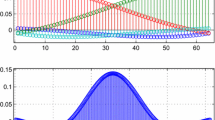Abstract
Previously, the timing estimation in OFDM system employs cyclic prefix has been presented with the assumption of independent identified distributed OFDM symbol. The information used to find the symbol synchronization depends on the length of cyclic prefix. Actually, the data in the BPSK-OFDM modulated symbol, transferred by inverse fast Fourier transform, is with a complex symmetry character. With this character, more information from the whole OFDM symbol could be provided for the symbol timing. In this paper, the proposed algorithm uses the autocorrelation of the received signal to obtain the symbol timing. The simulation of Beek’s algorithm and the proposed scheme are presented. The performances of these algorithms are evaluated based on the missing symbol probability and the estimator mean square error. The simulation results show that the proposed algorithm is suitable to achieve a better symbol synchronization.
Similar content being viewed by others
References
Zeng M., Annamalai A. Bhargava V.K. (1999). Recent advances in cellular wireless communications. IEEE Communications Magazine, 37(9): 128–138
Zhang, P. & Li, L. (2003). Research on beyond 3G mobile communications. In Proceedings of international conference on communication technology proceedings (ICCT 2003) (Vol. 1, pp. 28–31), Apr. 2003.
Prasad, R. (2004). OFDM for wireless communications systems. Artech House, Aug. 2004.
van Nee, R. & Prasad, R. (2000). OFDM wireless multimedia communication. Artech House Boston London.
Engels, M. (2002). Wireless OFDM systems: How to make them work? (1st ed.) Kluwer Academic Publishers.
Zou W.Y., Wu Y. (1995). COFDM: An overview. IEEE Transactions on Broadcasting, 41(1): 1–8
Hanzo, L., Webb, W. Keller, T. (2000). Single- and multi-carrier quadrature amplitude modulation—Principles and applications for personal communications, WLANs and broadcasting. John Wiley & Sons, Ltd.
Pandharipande A. (2002). Principles of OFDM. IEEE Potentials, 21(2): 16–19
Zhang Z., Long K., Zhao M., Liu Y. (2005). Joint frame synchronization and frequency offset estimation in OFDM systems. IEEE Transactions on Broadcasting, 51(3): 389–394
Yang B., Letaief K.B., Cheng R.S. Cao Z. (2000). Timing recovery for OFDM transmission. IEEE Journal on Selected Areas in Communications, 18(11): 2278–2291
Park B., Cheon H., Ko E., Kang C. Hong D. (2004). A blind OFDM synchronization algorithm based on cyclic correlation. IEEE Signal Processing Letters, 11(2): 83–85
van de Beek J.-J., Sandell M. Borjesson P.O. (1997). ML estimation of time and frequency offset in OFDM systems. IEEE Transactions on Signal Processing, 45(7): 1800–1805
Tufvesson, F., Edfors, O. & Faulkner, M. (1999). Time and frequency synchronization for OFDM using PN-sequence preambles. In Proceedings of IEEE vehicular technology conference, Vol. 4, pp. 2203–2207, Sep. 1999.
Ren G., Chang Y., Zhang H. Zhang H. (2005). Synchronization method based on a new constant envelop preamble for OFDM systems. IEEE Transactions on Broadcasting, 51(1): 139–143
Athaudage, C. R. N., & Krishnamurthy, V. (2002). A low complexity timing and frequency synchronization algorithm for OFDM systems. In Proceedings of IEEE global telecommunications conference, Vol. 1, pp. 244–248, Nov. 2002.
O’Hara, B., & Petrick, A. (1999). IEEE 802.11 Handbook—a designer’s companion. IEEE Press.
Supplement to IEEE Standard for Information Technology—Part 11: Wireless LAN Medium Access Control (MAC) and Physical Layer (PHY) Specifications: Further Higher-Speed Physical Layer Extension in the 2.4 GHz Band, IEEE Std. 802.11g/D2.1, Jan. 2002.
Supplement to IEEE Standard for Information Technology—Part 11: Wireless LAN Medium Access Control (MAC) and Physical Layer (PHY) Specifications: High-Speed Physical Layer in the 5 GHz Band, IEEE Std. 802.11a, 1999.
Author information
Authors and Affiliations
Corresponding author
Rights and permissions
About this article
Cite this article
Wen, JH., Lee, GR., Kuan, WH. et al. Performance evaluation of a new BPSK-OFDM timing estimation algorithm. Wireless Pers Commun 43, 1323–1331 (2007). https://doi.org/10.1007/s11277-007-9304-1
Received:
Accepted:
Published:
Issue Date:
DOI: https://doi.org/10.1007/s11277-007-9304-1



